
Welcome to saintpaulsnakes.com! I am David, a snake enthusiast living in Saint Paul, MN. Many people don't know that Saint Paul is in fact full of snakes! You just need to know where to find them - they can often be shy and elusive. Some Minnesota snake species are more common outside of the city limits, in different parts of Ramsey County MN, but many types of snakes are indeed common in the more urban parts of Saint Paul. This guide is meant to help educate you about the beautiful snakes of Saint Paul, and to help you identify the most common snakes of Saint Paul, as well as the venomous snakes of Saint Paul that you should learn to recognize and avoid. If you want more detail, click here for my complete list of ALL snake species in Saint Paul. Remember the following:
- Most snakes of Saint Paul are harmless and don't want to encounter you
- Venomous snakes exist but are uncommon in Saint Paul, Minnesota
- Snakes eat rats and mice and are a valuable part of the Minnesota ecosystem
- Never kill a snake - if you leave a snake alone, it will leave you alone.
Common Snake Species in Saint Paul
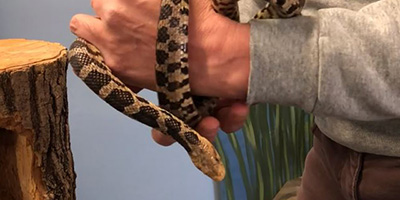 Western Fox Snake:
(Mintonius ramspotti)
Western Fox Snake:
(Mintonius ramspotti)Appearance: The western fox snake is a medium-build snake with a body length ranging from 36-56 inches. It's classified as one of the largest snakes of Minnesota. This reptile has a gray, light brown to yellow-tan body with dull spots on either side. Additionally, it has a pale-yellow belly with brown to black marks.
Habitat: This snake species lives in wet to moist areas, including river bottoms, prairies, woodland openings, and agricultural fields. Frogs, birds and their eggs, and rodents like mice form part of the snake's diet.
Behavior: The western fox snake exhibits different behaviors depending on the season. That said, it's nocturnal during summer, while during fall and spring, it's diurnal. When frightened, it discharges a foul smell to repel its enemy.
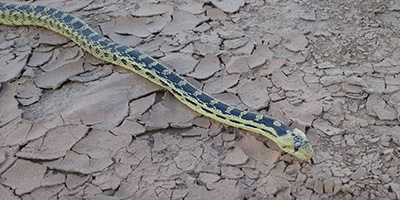 Gopher Snake:
(Pituophis catenifer)
Gopher Snake:
(Pituophis catenifer)
Appearance: The gopher snake is a huge, heavy build snake with a body length ranging from 37 to 72 inches. It has a yellow head with a sharp nose, straw-yellow back, and a black-brown banded tail.
Habitat: This species inhabits stiff and dry sand prairies—areas with loose, well-drained soils like gravel and sand. It feeds on mice, birds, and their eggs.
Behavior: During winter, this reptile hibernates under rocks in high cliffs, outcrops, and mammal burrows. During this time, activities like reproduction are minimized.
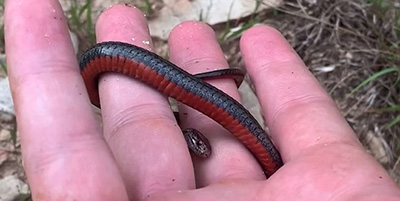 Red-bellied Snake:
(Storeria occipitomaculata)
Red-bellied Snake:
(Storeria occipitomaculata)
Appearance: The red-bellied snake is a small-bodied species measuring 8 to 16 inches in length. Besides that, it has a bright red, pink, or orange belly, while the rest of the body is brown or red-brown.
Habitat: This snake has a wide range of homes ranging from cool, damp, or moist places like woodlands and deciduous forests, to dry areas like grasslands and pastures. Moreover, they love river bays and other areas with lots of snails, worms, and slugs, which they feed on.
Behavior: Typically, red-bellied snakes are active during the day, especially after the rainy season. During this time, they get more than enough food as their prey are also active. However, they escape the excess solar burn of summer and remain active at night.
Venomous Snake Species in Saint Paul
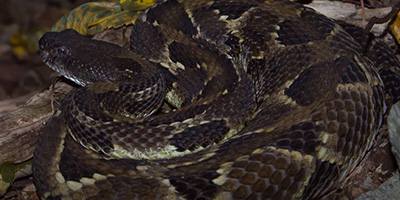 Timber Rattlesnake:
(Crotalus horridus)
Timber Rattlesnake:
(Crotalus horridus)
Appearance: The timber rattlesnake is also known as the velvet tail or cane break. It's a heavy-built snake with a body length ranging from 30 to 48 inches. This reptile is tan to gray. Additionally, it has keeled scales and a barred body pattern.
Habitat: The timber rattlesnake occupies stiff prairies, forested bluffs, and south-facing rock exposures. It uses the rock outcrops for basking, while the forests are essential for feeding during summer. Timber rattlers are ambush hunters of insects, birds, and amphibians like frogs.
Behavior: In fall and spring, timber rattlesnakes are diurnal. However, they change this pattern to nocturnal during the hot summer. These creatures hibernate in deep crevices and caves during winter but bask on sunny days of the season.
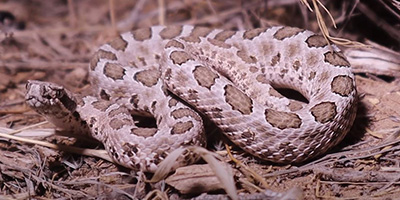 Eastern Massasauga Rattlesnake:
(Sistrurus catenatus)
Eastern Massasauga Rattlesnake:
(Sistrurus catenatus)
Appearance: The eastern massasauga snake is a relatively medium-thick species measuring 18.5 to 30 inches long. Body color ranges from gray, tan, to gray-brown with a black belly. They have faint stripes on the back, which extend to form stripes at the tail.
Habitat: This snake species lives in the stiff wet areas of St. Paul. South-facing prairies with underground dens are preferably suitable for hibernating during winter before they resurface during spring. They feed on voles, other snakes, and rodents.
Behavior: During winter, the eastern massasauga rattlesnake hibernates in areas with moist soils—under tree roots, logs, mammal burrows, or crayfish burrows. They emerge in spring to mate.
If you're unsure, you can email me a photo of the snake at info@saintpaulsnakes.com and I will email you back with the snake's species. If you found a snake skin, read my Found a Skin? page, and you can email me a photo of the skin, and I'll identify the snake for you. If you need professional Saint Paul snake removal help, click my Get Help page, or see the below website sponsor I found, who provides that service.
Remember, the term is not poisonous snakes of Saint Paul, it's venomous snakes of Saint Paul. Poison is generally something you eat, and venom is injected into you. That said, dangerous snakes are very rare in Saint Paul. The few venomous snakes of Ramsey County are rarely seen. But they are commonly misidentified, so learn about all the snake species of Saint Paul in order to correctly identify them. These snakes are usually also found in the surrounding towns of Saint Paul, Maplewood, Roseville, Shoreview, Arden Hills, Mounds View, Vadnais Heights, Little Canada, North Saint Paul, North Oaks, New Brighton, Falcon Heights, Lauderdale, Gem Lake, and the surrounding areas.
Read our article about:
Do Snakes Have Bones?
saintpaulsnakes.com domain and hosting costs made possible by the generous support of this sponsor:
